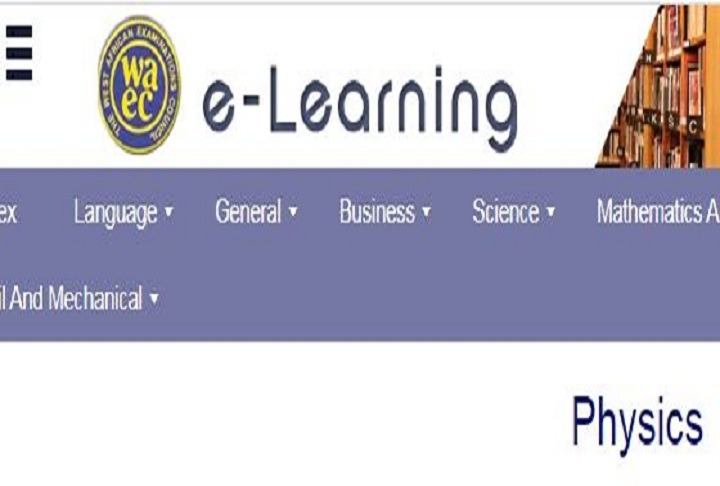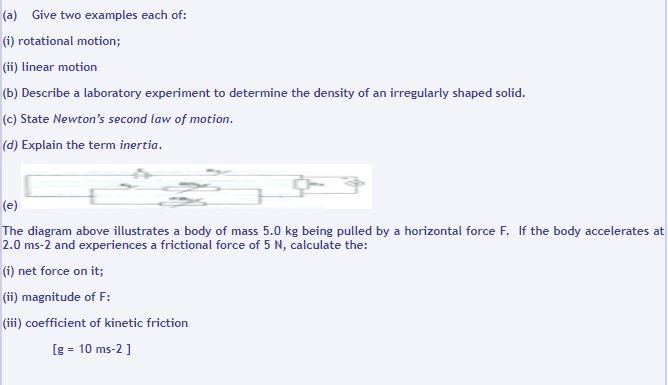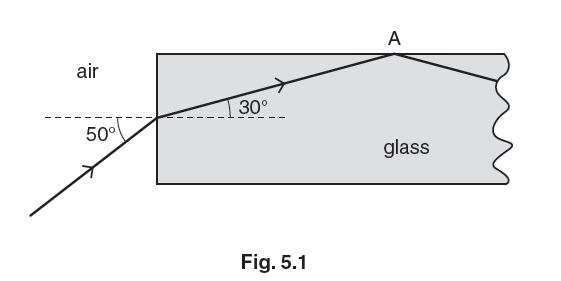WAEC Physics 2024 Answers for Essay-Obj Questions Released.
The Waec physics answers for 2024 questions can now be seen here. The West African Examination Council (WAEC) Physics paper will be taken on Tuesday, 21st May 2024.
WAEC Physics questions and answers for essay objectives are now available. The Waec Physics 2 (Essay) paper will start by 2:00 pm and will last for 1hr 30 mins while the Waec Physics 1 (Objective) exam will commence at 3:30 pm and will last for 1hr 15 mins.
Following recent reviews, it has been found out that the weaknesses of candidates in WAEC Physics questions included a lack of understanding of the fundamentals of the course, inability to take precise measurements to the required accuracy, inability to plot graphs correctly and disregard of instruction, which makes them loose precious marks.

In this post, we will be sampling waec physics questions for candidates that will participate in the SSCE examination from past questions.
WAEC Physics Answers 2024 Questions.
PAPER 2 [Essay]
Read Instructions.
Write your answers in the answer booklet provided.
1. Explain why mercury does not wet glass while water does.
ANS: Mercury does not wet glass because (force of) cohesion/attraction of mercury molecules is greater than (force of) adhesion/attraction between glass and mercury molecules.
Water wets glass because (force of) adhesion/attraction between glass and water molecules is greater than (force of) cohesion/attraction of water molecules
2. (a) State Faraday’s second law of electrolysis.
(b) An electric charge of 9.6 x 104 C liberates 1 mole of substance containing 6.0 x 1023 atoms. Determine the value of the electronic charge.
ANS: (a) If the same quantity of electricity is passed through different voltameters/electrolytes connected in series the masses of the substances liberated/deposited during electrolysis is (directly) proportional to their chemical equivalents.
(b) Let e represent the electronic charge.
e = Faraday’s constant
Avogadro’s number
= 9.6 x 104
6. 0. x 1023
= 1.60 x 10-19C
3. State: the difference between plane polarized light and ordinary light;
two uses of polaroids
ANS: In plane-polarized light, the vibrations of the particles are confined to a single plane perpendicular to the direction of propagation of light while in ordinary light, the vibrations of the particles are in all planes.
Uses of Polaroid
– sunglasses (to reduce the intensity of sunlight)
– to eliminate reflected light/glare
– saccharimeter/measurement of the concentration of sugar solution.
– stress analysis/photoelasticity.
4. (a) State Faraday’s second law of electrolysis.
(b) An electric charge of 9.6 x 104 C liberates 1 mole of substance containing 6.0 x 1023 atoms. Determine the value of the electronic charge.
ANS: (a) The mass of an element deposited /liberated during electrolysis is (directly) proportional to the chemical equivalent of the element.
(b) Let e represent the electronic charge.
e = Faraday’s constant
Avogadro’s number
= 9.6 x104
6. 0. x 1023
= 1.60 x 10-19C
5. Explain the following terms:
(a) tensile stress;
(b) Young’s modulus.
6. (a) Define diffusion.
(b) State two applications of electrical conduction through gases.
ANS: (a) Diffusion is the process by which substances mix with one another due to the random motion of their molecules.
(b) Applications of electrical conduction through gases include:
– In the advertising industry/ Neon signs
– In lighting/ fluorescent tubes
– Identification of gases
– Cathode ray oscilloscope/ T.V. tubes.
7. (a) List two properties of cathode rays.
(b) Explain how the intensity and energy of cathode rays may be increased.
ANS: (a) Properties of cathode rays:
– They are negatively charged.
– travel in a straight line in a field-free space.
– are deflected by an electric/magnetic field.
– possess (kinetic) energy.
– possess momentum.
(b) The intensity of cathode rays may be increased by raising the temperature of the cathode /increasing the current through the heater.
They may be increased by raising the potential difference between the anode and the cathode/anode potential.
8. Give three observations in support of de Broglie’s assumption that moving particles behave like waves.
9. (a) Differentiate between plane polarization and interference as applied to waves.
(b) List two uses of polaroids.
ANS: (b) They are used in:
– production of 3-dimensional films
– determination of the concentration of sugar solution
– polaroid cameras
– sunglasses.
10. (a) State two factors that affect the mass of elements deposited during electrolysis.
(b) List two non-electrolytes.
ANS: (a) time, current /quantity of charge, nature/ e.c.e of the element.
(b) water, kerosene, petrol, benzene, ethanol.
11.

12. (a) i. State two advantages of alcohol over mercury as a thermometric liquid.
ii. When the bulb of a thermometer is placed in a beaker of hot water, the level of mercury first falls and then rises gradually. Explain this observation.
(b) List two factors, other than temperature, that affect the rate of evaporation of a liquid.
(c) A block of lead of mass 100kg in a crucible and at a temperature of 40oC was placed in an electric furnace rated 10kW. If the melting point of lead is 320oC, calculate the:
(i) quantity of heat required to heat the lead to its melting point;
(ii) additional heat energy required to melt the lead;
(iii) time taken to supply this additional energy.
(Specific heat capacity of lead = 120JKg-1 K-1
(Specific latent heat of fusion of lead = 2.5 x 104 JK-1)
(d) State two precautions necessary in an experiment to determine the specific latent heat of vaporization of water.
ANS: (a) i. Advantages of alcohol over mercury as a thermometric liquid
– lower freezing point
– cheaper
– easily expansively.
ii. the glass of the bulb of the thermometer first expands; hence the mercury level fails. The expansion of the mercury increases more than that of the glass and the liquid rises.
(b) Factors other than temperature affecting the rate of evaporation of a liquid
– wind
– humidity/ dryness of the air
– nature of liquid/ viscosity /density
– the area of liquid exposed
– pressure.
13. (a) State two factors that affect the angle of deviation of a ray of light through a triangular glass prism.
(b) Seven virtual images of an object are formed when two plane mirrors are inclined at an angle 0 to each other. Calculate the value of 0.
(c) By means of a ripple tank, a student was able to generate a series of transverse waves by varying the frequency ofthe dipper, and all the generated waves covered a distance of 0.80 m in 0.2 s.
(i) Determine the speed, v, of the waves
(ii) Copy and complete the table given above in your answer booklet.
(iii) Plot a graph with f on the vertical axis and h -1 on the horizontal axis.
(iv) What does the slope of the graph represent?
14. The Fig. 5.1 below shows a ray of light entering and passing along an optical fibre.

(a) Calculate the refractive index of the glass in the optical fibre.
(b) Explain why the ray of light is totally internally reflected at A.
(c) Both optical fibre and copper wire are used to transmit data. Optical fibre is cheaper and can carry more data per second than copper wire.
State one other advantage of using an optical fibre rather than copper wire to transmit data.
15. (a) State two differences between a sound wave and a radio wave
(b) Explain why a vibrating tuning fork sounds louder when its stem is pressed against a tabletop than when held in air.
(c) State two conditions necessary for the:
i. production of stationary wave in a medium;
ii. formation of interference wave patterns;
iii. occurrence of total internal reflection of a wave.
(d) i. A ray of light is incident on one face of an equilateral glass prism. Draw a ray diagram to show the path of the ray through the prism.
ii. Calculate the refractive index of the glass if the angle of minimum deviation is 41o.
WAEC Physics Objective Questions 2024.
Paper 1 [Objective]
Answer ALL questions in this section.
Shade your answers on the answer booklet provided.
1. An electron moves with a speed of 2.00 x 107 ms-1 in an orbit in a uniform magnetic field of 1.20 x 10-3T. Calculate the radius of the orbit.
[Mass of an electron = 9.11 x 10-31kg; charge on an electron = 1.61 x 10-19C]
2. A tennis ball projected at an angle attains a range R = 78 m. If the velocity imparted to the ball by the racket is 30ms-1, calculate.
[g=10ms-2]
3. A metallic bar 50 cm long has a uniform cross-sectional area of 4.0 cm2. If a tensile force of 35kN produces an extension of 0.25 mm, calculate the value of Young’s modulus.
4. A stone projected horizontally from the top of a tower with a speed of 4 ms-1 lands on the level ground at a horizontal distance of 25 m from the foot of the tower. Calculate the height of the tower.
[g = 10 ms-2]
5. A spiral spring with a metal extends by 10.5cm in air. When the metal is fully in water, the spring extends by 6.8 cm. Calculate the relative density of the metal (Assume Hooke s law Is obeyed)
6. A ray of light is incident on an air-glass boundary at an angle t? If the angle between the partially reflected ray and the refracted ray is 90°, calculate θ given that the refractive index of glass is 1.50.
7. A ball is projected horizontally from a height with a velocity of 40 ms-1. Calculate the drop in height after traveling a horizontal distance of 30m.
[Neglect air resistance; g = 10 ms-1]
8.
NOTE: There is nothing like the Waec physics expo online. Do not be deceived by fraudsters posing with fake Waec physics answers on the internet. The resources above on WAEC Physics Answers have been made available to assist candidates understand the required standards expected in Physics final Examination.
Keep following, more questions and answers will be added soon.
